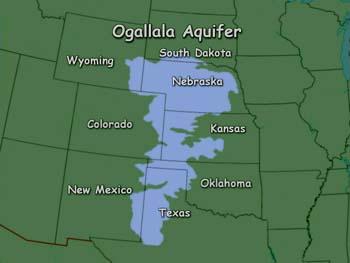
Agricultural News
USDA Offices Studying the Possibility of a Future Without the Ogallala Aquifer
Mon, 15 Jul 2019 11:52:42 CDT
 With the Ogallala Aquifer being an invaluable resource for communities throughout the eight states it lies, studies to keep the water levels steady are continuing in the South Plains in the hopes of delivering more tools and technology to help with conservation in agriculture.
With the Ogallala Aquifer being an invaluable resource for communities throughout the eight states it lies, studies to keep the water levels steady are continuing in the South Plains in the hopes of delivering more tools and technology to help with conservation in agriculture.
The U.S. Department of Agriculture office in Lubbock studies several different possibilities in their research regarding the aquifer, including the idea that the aquifer may not be able to be used in the future. A big focus of the Lubbock USDA's research is gear towards what the best farming practices can be with only rainfall, as they try to get away from using the Ogallala Aquifer.
"We have storms where you get a lot of rain that comes very quickly," said Robert Lascano, research leader at the Lubbock USDA. "The soil doesn't have the physical properties to absorb that so a lot of it runs off. So we look at ways we can take that water from the rainfall and try to store as much as we can, and minimize the amount of runoff."
One way to do that is by having more dryland than irrigated acres. Lascano points to Martin County as an example for how farmers can work with dryland, and in Lubbock County there are currently a 60 percent irrigated land and 40 percent dryland. This way would also be useful when the quality of water in the aquifer changes due to the salt levels.
"We have hard water, and as the water level goes down, the concentration of salts are in less volume of water so the concentration goes up as we deplete the aquifer," said Lascano. "What happens to the remaining water and how is that going to affect the crop? Cotton has a high tolerance for the sale but others do not."
Technology is also a big resource in the agriculture community, as Lascano explained there are tools to show when the best time to plant is, what the soil temperature is, and how much fertilizer and pesticides are needed. The cotton crop itself might be another solution, if producers are able to try crop rotation with grain sorghum, which is drought-tolerant.
"For many years, it's been cotton after cotton after cotton," said Lascano. "Now, people are realizing that now maybe isn't the best farming practice, and the best practice might be rotating grain sorghum with cotton. But what drives all this is economics and it's a high-risk environment - so we can have all these decisions based on good science, but it doesn't necessarily mean there's a profitability for producers."
Steve Evett, Research Soil Scientist for the USDA in Bushland, said they have changed several practices while researching ways to cut down on the aquifer's use including switching impact sprinklers on center pivot pipes to using drops, low pressure applicators, and now low-elevation spray application. Now, the focus is on irrigation management.
"Right now the point of attack is better center pivot irrigation management and better technology," said Evett. "You can fine tune where in the field you can put water and in different zones on the field. The problem with that technology at this time is the management because we have the equipment to apply water at variable levels in the fields, but we haven't until recently had the ability to have a system that allows the farmer to know where."
Cattle are also at risk for the effects of a depleting aquifer, as they are unlikely to drink water that is too salty. John Stout, physical scientist at the Lubbock USDA, is monitoring water in local springs and rain water that has run off into lakes. This year, Stout's team detected water that wasn't too salty for cattle after a significant rain event.
"There's a point where the cattle will not drink water if it gets too salty," said Stout. "The aquifer here is pretty good water, but as you get off the Caprock and into the Rolling Plains, the groundwater becomes very salty so they can't even use the water."
Research is also being done that studies different isotopic signatures. Tim Goebel, research scientist, says this will help to show how deep rain was able to infiltrate the soil compared to water that was in the soil previously, and then see how different irrigation methods or crop rotation helps.
All the tools are available to farmers in West Texas as the USDA continues to develop them, and Lascano says they are always working on more ways to help.
"The things we can do now in agriculture are unbelievable and they're being used," said Lascano. "These farmers are savvy, and they know and want these tools."
Source - AGN Media
WebReadyTM Powered by WireReady® NSI
Top Agricultural News
More Headlines...



















